(CNN) —
As the sunshine sticks around for longer periods and the air becomes crisp and fresh, you may dream of a lush backyard full of colorful blooms, or even a vegetable and herb garden where you can easily pick a vine-ripe tomato and basil for your evening salad. These visions are lovely, but the reality of growing a green thumb is a little trickier than snapping your fingers.
Gardening, while beneficial for our mind and spirit, takes practice and patience to master. It’s also a game of trial and error, as some seedlings will prosper and others will never see the light of day. The good news is digging in the dirt, tending to your baby plants and, finally, seeing progress will motivate and empower you.
To give you a head start on your success, we’ve created an essential guide for beginner gardeners. First, you’ll find top expert recommendations for what to buy in your gardening tool kit. Then you can follow the ideal step-by-step process of mapping out your gardening game. From gloves to shovels, you’ll be the envy of the neighborhood in no time.
Make sure you have all of the necessary items on hand so when you’re ready to begin the gardening process you won’t be left scrambling.
This visualization tool allows you to plan your garden bed using exact measurements and a grid pattern, explains Joyce Mast, the plant mom for Bloomscape. “It can help make sure each plant you choose has the appropriate amount of room to grow and flourish, and it also helps you choose what plants to purchase for your garden. Generally, this is based on the amount of sunlight the areas receive per day,” she explains.
The Gardener’s Logbook ($9.99; amazon.com)
Amazon
The Gardener’s Logbook
Like the “supergreens” you take every morning to jump-start your day, Mast says fertilizer is essentially a superfood for plants that can help them grow vibrant, eye-catching blossoms and foliage all season long. While fertilization is ultimately up to you, she recommends mixing a slow-release fertilizer into the soil before planting to ensure healthy, strong plants. Then she says to supplement with a liquid water-soluble fertilizer once a month.
Miracle-Gro Shake ‘n Feed All Purpose Plant Food ($12.98; homedepot.com)
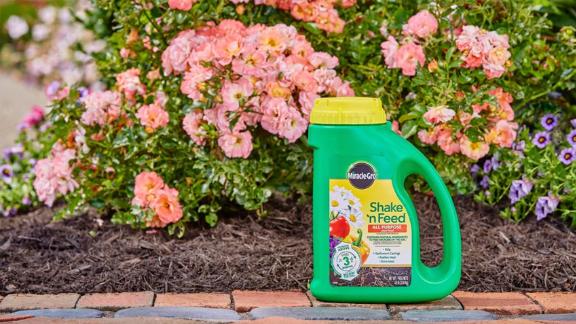
Home Depot
Miracle-Gro Shake ‘n Feed All Purpose Plant Food
Osmocote Smart-Release Plant Food Plus Outdoor & Indoor ($7.59; amazon.com)
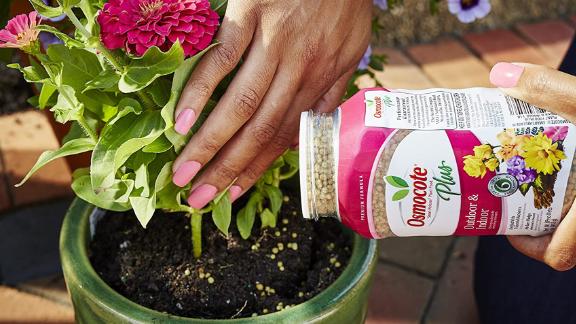
Amazon
Osmocote Smart-Release Plant Food Plus Outdoor & Indoor
Quentin Vennie, an author, certified home horticulturalist and the Greenhouse Tea Company’s co-founder, says it’s vital to get your hands dirty — literally — when you’re gardening, but what’s the likelihood of you wanting to touch compost, manure and earthworms daily? Yuck! A few pairs of gardening gloves will fight the ick and protect your manicure. And if you want to ensure your clothes don’t get muddled with muck, try an apron too.
Cooljob Gardening Gloves ($13.99, originally $19.99; amazon.com)

Amazon
Cooljob Gardening Gloves
Typhon East Garden Apron With Pockets and Kneeling Pads ($28.95; amazon.com)
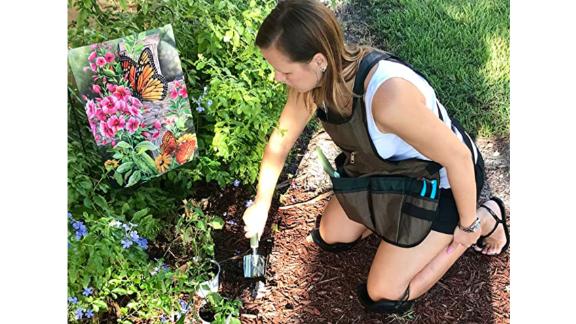
Amazon
Typhon East Garden Apron With Pockets and Kneeling Pads
And no, we’re not talking about what you find in a deck of cards. One of the most important things is ensuring proper root health and development with gardening, Vennie explains. “One of the easiest ways to support that is to make sure you are planting at the proper depth,” he says. “It is helpful to have a spade on hand to dig a proper space for your plant to grow. Different plants have different depth requirements, so do your research to make sure you are providing the roots with enough space and depth to grow.”
Fiskars 46-Inch Steel D-Handle Square Garden Spade ($31.34; amazon.com)
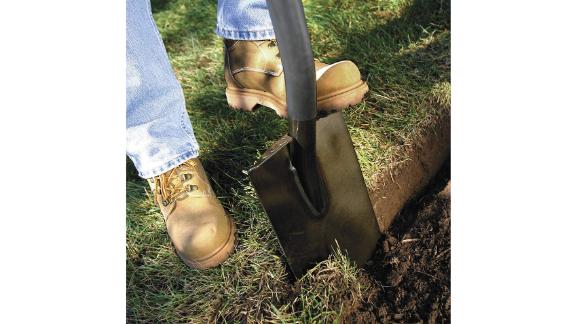
Amazon
Fiskars 46-Inch Steel D-Handle Square Garden Spade
If you’re creating a lush backyard or patio filled with tomatoes, herbs, flowers and more, it’s hard to remember which seeds are planted where. Vennie says plant markers are helpful for your memory and provide guidance on plant neighbors. “Some plants like oregano grow very wild and could potentially take over a very small space in a short period of time, which also means its root system is taking up space,” he says. “Without proper space for the roots to grow, other plants will die. Use your plant markers to keep your garden organized.”
Kinglake Plastic Plant T-Type Tags Nursery Garden Labels, 100-Pack ($7.99, originally $10.99; amazon.com)

Amazon
Kinglake Plastic Plant T-Type Tags Nursery Garden Labels, 100-Pack
Yep, you’re becoming a farmer…but maybe with smaller tools. A cultivating fork resembles a shovel but has four long prongs instead of a large spade head. This tool will help you break up compacted or clay soils without destroying whatever life you have left, like earthworms, explains Troy Smothermon, the co-founder of StartOrganic. “You’ll use it every season to spread and mix organic compost and other soil amendments into your soil,” he adds.
True Temper 2812200 4-Tine Spading Digging Fork ($24.98, originally $26.99; amazon.com)
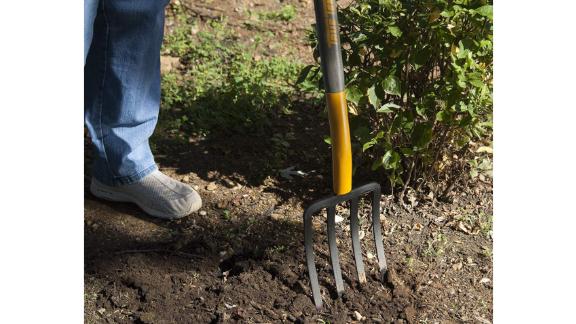
Amazon
True Temper 2812200 4-Tine Spading Digging Fork
Smothermon says this tool is useful for digging small holes, planting your starter plants and weeding. With this and other tools, he says it’s best to avoid plastic garden tools. “They break down in the sun and become brittle, causing them to break quickly,” he continues. “Look for one-piece trowels where the handle and the heads are all metal and all one piece.”
Tacklife 6-Piece Gardening Set ($37.97; amazon.com)
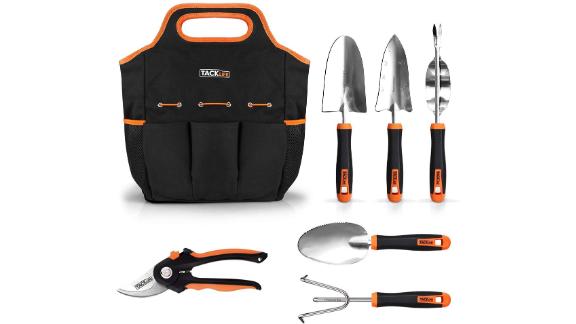
Amazon
Tacklife 6-Piece Gardening Set
Wilcox All-Pro 202S Stainless Steel Garden Trowel (starting at $13.99; amazon.com)
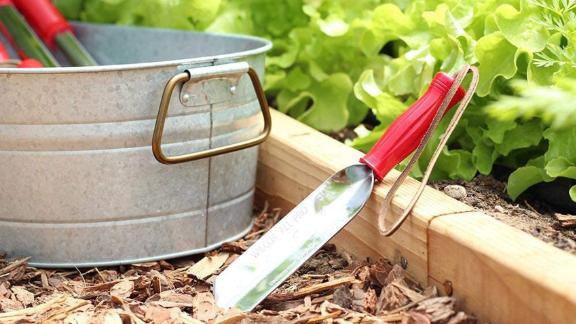
Amazon
Wilcox All-Pro 202S Stainless Steel Garden Trowel
Make sure they’re like a razor — and keep it simple. “One good, sharp set of pruning shears is all you need,” Smothermon says. “A good, old-fashioned metal shear with a metal spring will last forever. You’ll use these for harvesting produce, pruning plants and general garden maintenance.”
Fiskars Pruning Shears ($12.83; amazon.com)
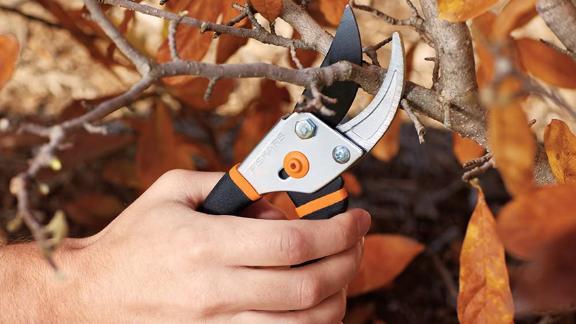
Amazon
Fiskars Pruning Shears
Take some of the pressure off of yourself when tending to your garden by investing in a basic irrigation system. As Smothermon explains, these are not only easy to install, but they also typically cost less than $100 and save you tons of time. “Timers that connect to hose outlets make watering easy,” he says. “Plant each of your plants underneath where each drip comes out. You’ll cut your garden maintenance time in half.”
You can also go for a large watering can that allows you to switch between different water streams if you don’t have quite enough space for an irrigation system.
Flantor Garden Irrigation System ($25.99, originally $27.98; amazon.com)
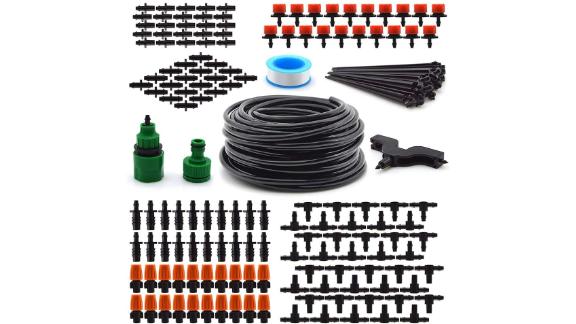
Amazon
Flantor Garden Irrigation System
Hortican Galvanized Watering Can ($42.99; amazon.com)
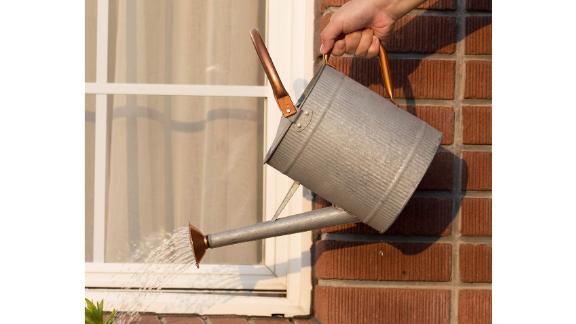
Amazon
Hortican Galvanized Watering Can
It’s not only fashionable but also practical to invest in a floppy, fun hat. It will protect you from the sun, keep you cool and put you in the right mindset to tend your plants, says Brandy Hall, the founder and managing director of Shades of Green Permaculture. “I find putting on a good sun hat marks the start of the ritual and the job of gardening, sort of like a uniform,” she says. “My household knows when I’m wearing my sun hat, it’s my time in the garden.”
Furtalk UPF 50 Summer Hat (starting at $22.99; amazon.com)

Amazon
Furtalk UPF 50 Summer Hat
This annual guide has been valued by farmers for more than 100 years and is definitely worth your attention. As Kari Warberg Block, an author, certified master gardener and the CEO of EarthKind, explains, this is a trusty friend for gardeners just starting out, as it guides you with long-range weather predictions and helps you determine when it’s best to do specific gardening tasks and know what to plant for your region. “The cycles of the planets can affect plants as much as the cycles of the seasons. Planting in harmony with all the elements is, well, elemental,” she adds.
The Old Farmer’s Almanac 2021 (starting at $5.99; amazon.com)

Amazon
The Old Farmer’s Almanac 2021
First, identify your cold hardiness zone
Though it would be wonderful to fill your green space with avocado trees, unfortunately not all plants thrive in every climate. That’s why it’s essential to understand the right investments for your zip code. You can determine your cold hardiness zone by visiting the USDA website, explains Gladys Mbofung-Curtis, a plant biologist for the Garden Safe Brand. This will help you identify and narrow down your shopping list to only those with superior performance in your area. “The classification of each zone is based on the average minimum temperature in a given area of the country,” she says. “Each zone is separated by 10 degrees from the next.”
For example, if your location belongs to zone 7, you could still grow plants that belong to zones 6 and 8. Thus, this is a general guide. As a warning, though, she does note that the determination of cold hardiness is not an exact science, because many factors influence a plant’s cold hardiness.
Know the difference between annuals versus perennials
Choosing between an annual versus a perennial comes down to what type of flowers you prefer as well as how much effort you want to give to your garden. Typically, nurseries will separate these into different sections, and you can always check the stick in the soil or the package labeling for more information. Generally speaking, though, this is what you need to know, according to Mast.

iStock
Annuals are planted in the spring after the last frost and will live throughout the spring and summer. “They must be planted again every year because of their life cycle and the fact that they are not typically cold-hardy,” she continues. “Annuals usually require more hands-on care, including regular watering and pruning. Many varieties produce beautiful blooms that last for the whole summer.”
Perennials may be planted in the spring or fall, depending on the variety, and will live for many years. “They are usually lower maintenance, typically only requiring watering during the first year that they are planted, and after that, they are hands-off. Some varieties will require pruning around once a year; others will require none at all.”
Strategize with sunlight in mind
Before you plant anything, pay attention to where those rays of light land in your intended garden area, and track how many hours vitamin D shines down. As Mast explains, your home’s mix of sun and shade will also determine which outdoor plants should be in your garden. Luckily, nearly all nurseries or plant shops classify between full sun, partial sun or full shade. This allows you to find what works best for your location.
As an example, Mast says flowers like geraniums, petunias and calibrachoas require full sunshine to bloom beautifully. The same goes for the vast majority of herbs and vegetables, which need a solid eight to 10 hours of bright sunlight to thrive. On the other hand, impatiens, coleus and begonia can thrive in shadier spots.
Plot your planting before digging
Now that you’ve determined the right options for your specific spot and mapped the sunshine, it’s time to plot your planting map. If you’re starting gardening for the first time, make sure you first use a notebook to draw out the plot to plan the spacing, the seeding dates and harvest dates, recommends Block. Not only will this save your wallet from wasting money on plants that will perish, but it’ll also help to boost your confidence when you see growth!
“Plan out your garden beds, then be sure to mark out your garden rows. This helps to create rhythm and will keep your garden organized,” she continues. “You can do this by using a string tensioned between two stakes, which can be as simple as using two pencils for anchors. This will keep your rows straight and keep seeds properly distanced along the seed line.”
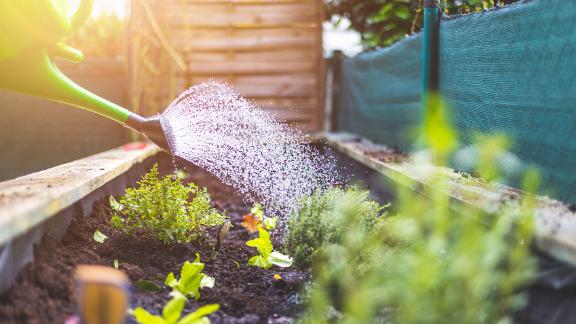
iStock
Create a watering schedule
In addition to sunshine, all plants also need good ol’ fashioned H20! And they require significantly more than your indoor beauties. That’s why Mbofung-Curtis recommends creating a schedule you can stick to — and remember. Though natural rainfall, of course, helps, you still need to make sure you’re keeping the soil moist. She says it’s best to do your watering early in the morning or late in the evening.
“Water the base of the plant and never water the leaves to avoid creating damp foliage that will cause some fungi to grow,” she adds. You can use a watering can or install an irrigation system, but determine how much watering your plants need by doing a simple test, she says:
- Apply water to the raised bed until the soil is wet
- Allow it to dry and check daily with a handheld moisture meter
- If the moisture level is below 5, then your garden needs more water
“During the spring, you can water your garden every two days and increase watering to every day in the hot summer months,” she continues. “If automation is possible, install a drip irrigation or soaker hose close to your raised bed to avoid unintentionally soaking other areas and generating mud.”
Invest in soil and fertilizer
Your plants need to be planted in robust, vibrant soil to remain healthy. Believe it or not, soil provides your plants access to water, nutrients and air, explains Vennie. He says the ideal soil is called “loamy,” a combination of sandy and clay soil for vegetable gardening. “Loamy soil tends to be moist and crumbly to allow water to flow through easily and provides the roots with the necessary nutrients for healthy growth,” he explains.
Mbofung-Curtis also says that adding some fertilizer can be helpful, but make sure to shop smartly. “There are all sorts of fertilizers in the stores: for growing big fruits, for flowering plants and specialty fertilizers for plants such as roses,” she continues. “Choose wisely and accordingly to suit the herbs and veggies you choose to grow.”

iStock
Fight pests naturally, if you can
Sure, you can buy pesticides, but Block says in many instances you fight irritants naturally. In fact, sometimes certain pest-busting ingredients can benefit the health of your garden too. She recommends:
- To fight cockroaches, moths, beetles, ants and termites: Use cedar mulch in your garden and plant herbs like mint and thyme, and flowers like marigolds. “These scents function as powerful natural deterrents,” she says.
- To fight mosquitoes: Plant herbs like rosemary, geranium, basil, lavender, peppermint and garlic. “These are all offensive to their sense of smell,” she says.
- To fight the carrot fly: Plant rosemary and sage throughout carrot rows.
- To fight rabbits, deer and squirrels: Sprinkle cayenne pepper on garden topsoil. “The capsaicin creates an uncomfortable heat that will irritate the nasal and ocular membranes of invaders,” she says.
Don’t forget to prune and deadhead
To encourage healthy, new growth, Mast recommends regular pruning and trimming of your plant, which will lead to bushier plants. “A good rule of thumb when pruning is to avoid removing more than one-third of the plant at one time,” she continues. “It is crucial to trim your herbs regularly and pick vegetables as soon as they grow to maximum size and ripeness.”
Though indoor plants don’t need to be deadheaded, outdoor gardens enjoy the cleanse. To do this, Mast says to inspect your flowerpots or beds for wilting and/or browning flowers, then use a sharp, clean pruner and cut off the flower stem below the dying bloom and discard. “Wipe the blade clean after each cut to mitigate the spread of infections and diseases,” she adds.


